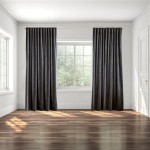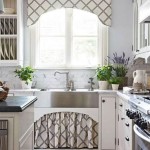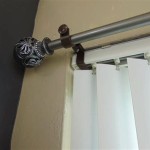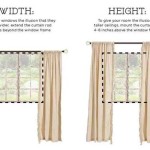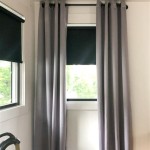Patio Door Single Panel Curtain: A Comprehensive Guide
Patio doors, designed to blend indoor and outdoor living spaces, often present unique challenges when it comes to window treatments. Their expansive size and functionality require careful consideration to ensure optimal light control, privacy, insulation, and aesthetic appeal. A single panel curtain emerges as a practical and versatile solution for addressing these needs, offering a seamless blend of functionality and style for patio doors.
The use of a single panel curtain offers a streamlined approach to covering a patio door. Instead of multiple panels, a single, wider piece of fabric spans the width of the door, creating a clean and modern look. This simplicity translates to ease of use, as the curtain can be effortlessly drawn open or closed, allowing for quick transitions between enjoying natural light and maintaining privacy.
Choosing the right single panel curtain for a patio door requires careful consideration of several factors, including fabric type, size, hardware, and additional features. This article will explore these aspects in detail, providing a comprehensive guide to selecting and implementing the ideal single panel curtain for enhancing the functionality and aesthetics of any patio door.
Key Considerations for Selecting a Patio Door Single Panel Curtain
Several critical factors influence the selection of the appropriate single panel curtain for a patio door. These factors cover aspects related to light control, privacy, energy efficiency, aesthetic considerations, and practical usability. Thoroughly assessing each of these areas will lead to a more satisfying and functional outcome.
1. Fabric Selection: Balancing Light, Privacy, and Insulation
The choice of fabric is arguably the most crucial element in selecting a single panel curtain. The fabric dictates the curtain's ability to control light, provide privacy, and contribute to energy efficiency. Options range from sheer and lightweight materials to thick and heavy fabrics, each offering a distinct set of benefits.
Sheer fabrics, such as voile or chiffon, allow a significant amount of natural light to filter through, creating a soft and diffused ambiance. While offering minimal privacy, they are ideal for spaces where maximizing natural light is a priority, such as sunrooms or patios with ample natural screening. These fabrics can also be layered with heavier curtains for added privacy and light control when needed.
Semi-sheer fabrics offer a balance between light filtration and privacy. They allow some light to pass through while obscuring the view from the outside, providing a moderate level of privacy during daylight hours. Linen and lightweight cotton blends fall into this category, making them suitable for living rooms and dining rooms where a balance between light and privacy is desired.
Room-darkening fabrics, such as microfiber or blackout fabrics, significantly reduce the amount of light entering the room. They are an excellent choice for bedrooms and media rooms where minimizing glare and maximizing darkness are essential. Blackout curtains are particularly effective at blocking out sunlight, making them ideal for shift workers or individuals sensitive to light.
Insulated or thermal fabrics are designed to improve energy efficiency by reducing heat transfer through the patio door. These fabrics often feature multiple layers, including a thermal lining, to provide enhanced insulation. By minimizing heat loss in the winter and heat gain in the summer, insulated curtains can help lower energy bills and create a more comfortable indoor environment.
In addition to light control and insulation, the fabric's texture and appearance play a significant role in the overall aesthetic of the room. Consider the existing decor and choose a fabric that complements the style and color scheme. Options range from smooth and sleek fabrics to textured and patterned materials, allowing for a wide range of design possibilities.
2. Determining the Appropriate Size and Dimensions
Accurately measuring the patio door is crucial for ensuring that the single panel curtain provides adequate coverage and hangs properly. The width and length of the curtain should be carefully considered to achieve the desired aesthetic and functionality.
To determine the appropriate width, measure the width of the patio door frame and add several inches on each side to allow for fullness and overlap. This overlap ensures that the curtain effectively blocks light and provides sufficient privacy when closed. A general rule of thumb is to add at least 12 inches to the total width, but more overlap may be desired for increased light control.
The length of the curtain is typically determined by the desired aesthetic and the height of the rod or track. Curtains can be hung to graze the floor, puddle slightly on the floor, or hang just below the window sill. Floor-length curtains are a classic choice that creates a sense of elegance and sophistication, while sill-length curtains offer a more casual and contemporary look. Puddling curtains can add a touch of drama and romance, but they may require more maintenance to keep clean.
When measuring for length, consider the placement of the curtain rod or track. If the rod is mounted above the door frame, measure from the top of the rod to the desired hemline. If the rod is mounted directly on the door frame, measure from the top of the frame to the desired hemline. It is essential to account for any rings or clips that will be used to hang the curtain, as these can affect the overall length.
For patio doors that extend from floor to ceiling, custom-made curtains may be necessary to achieve the perfect fit. Custom curtains allow for precise measurements and tailored finishes, ensuring a seamless and polished look. While custom curtains may be more expensive than off-the-shelf options, they offer a superior level of quality and customization.
3. Selecting the Right Hardware and Accessories
The hardware used to hang the single panel curtain plays a critical role in its functionality and aesthetic appeal. The choice of rod or track, rings or clips, and other accessories should be carefully considered to ensure proper operation and a cohesive design.
Curtain rods are a traditional and widely used option for hanging curtains. They are available in a variety of materials, including metal, wood, and plastic, as well as a wide range of finishes to complement any decor. The diameter of the rod should be appropriate for the weight of the curtain, and the brackets should be securely mounted to the wall or door frame.
Curtain tracks offer a more modern and streamlined alternative to curtain rods. They allow the curtain to glide smoothly along the track, making them ideal for large or heavy curtains. Tracks can be mounted to the ceiling or the wall, and they can be concealed behind a valance or cornice for a more discreet look.
Rings and clips are used to attach the curtain to the rod or track. Rings are typically sewn onto the top of the curtain and then slid onto the rod. Clips are attached directly to the curtain fabric and then clipped onto the rod or track. The choice between rings and clips depends on the desired aesthetic and the weight of the curtain.
Tiebacks and holdbacks are used to hold the curtain open and allow light to enter the room. Tiebacks are fabric straps that are attached to the wall or door frame and used to gather the curtain to one side. Holdbacks are decorative hooks or knobs that are mounted to the wall and used to hold the curtain in place. Both tiebacks and holdbacks add a touch of elegance and functionality to the curtain.
Additional accessories, such as valances and cornices, can be used to conceal the hardware and add a decorative touch to the curtain. Valances are fabric panels that are hung across the top of the window, while cornices are rigid structures that are mounted above the window. Both valances and cornices can be used to create a more formal and finished look.
4. Addressing Specific Concerns: Privacy, Light Management and Maintenance
Beyond the general selection criteria, specific concerns regarding privacy, light management, and maintenance must be addressed when choosing a single panel curtain for a patio door. These considerations will further refine the selection process and ensure a tailored solution.
For increased privacy, layering curtains provides an excellent solution. Combining a sheer or semi-sheer panel with a heavier, room-darkening panel allows for flexible light control and privacy options. During the day, the sheer panel can be used to diffuse light while maintaining a degree of privacy. At night, the room-darkening panel can be drawn to completely block out light and ensure privacy.
To further enhance light management, consider using curtains with adjustable features, such as drawstrings or tapes. These features allow you to control the amount of gathering and fullness in the curtain, which in turn affects the amount of light that enters the room. Drawstrings can be used to create a more gathered and voluminous look, while tapes can be used to create a more tailored and structured appearance.
Maintenance is another crucial consideration, particularly for patio doors that are frequently used. Choose fabrics that are easy to clean and maintain, such as machine-washable cotton or polyester blends. Avoid delicate fabrics that require dry cleaning, as these can be more expensive and time-consuming to maintain.
Regular dusting and vacuuming can help to keep the curtains clean and free of dust and debris. Spot cleaning can be used to remove minor stains and spills. For more significant stains, professional cleaning may be necessary. Following the manufacturer's instructions for cleaning and care will help to prolong the life of the curtain and keep it looking its best.
By carefully considering these key factors, homeowners can select the ideal single panel curtain for their patio door, enhancing the functionality, aesthetics, and comfort of their living space.

Nicetown Single Panel Patio Door Curtain Slider Blind Vertical Blinds Wide Width Blackout Curtains Drapes With Rod Pocket Back Tab Design Grey Sliding Draperies 100 Inches W X 84 L

108 X84 Loha Patio Grommet Top Single Curtain Panel Light Gray Exclusive Home Sliding Door Drapes Filtering

Thd Extra Wide Sheer Voile Patio Door Grommet Curtain Panel For Sliding Doors Single 100 Inches Wal Com

108 X96 Loha Patio Grommet Top Single Curtain Panel White Exclusive Home

Eclipse Kendall Ivory Polyester Solid 100 In W X 84 L Sliding Patio Door Grommet Outdoor Blackout Curtain Single Panel 28628204158 The Home

Goory Sheer French Door Curtains Rod Pocket Semi Voile Single Curtain Panel For Patio Doors Window Kitchen Decor Grey 54 72inch Wal Com

Sun Zero Gavin Sage Green Polyester 100 In W X 84 L Grommet Sliding Patio Door Blackout Curtain Single Panel 53483 The Home

Nicetown Single Panel Patio Door Curtain Slider Blind Vertical Blinds Wide Width Blackout Curtains Drapes With Rod Pocket Back Tab Design Grey Sliding Draperies 100 Inches W X 84 L

Sun Zero Conrad Extra Wide Blackout Sliding Patio Door Curtain Single Panel

How Do You Curtains For Door Windows The Blinds Spot
See Also


